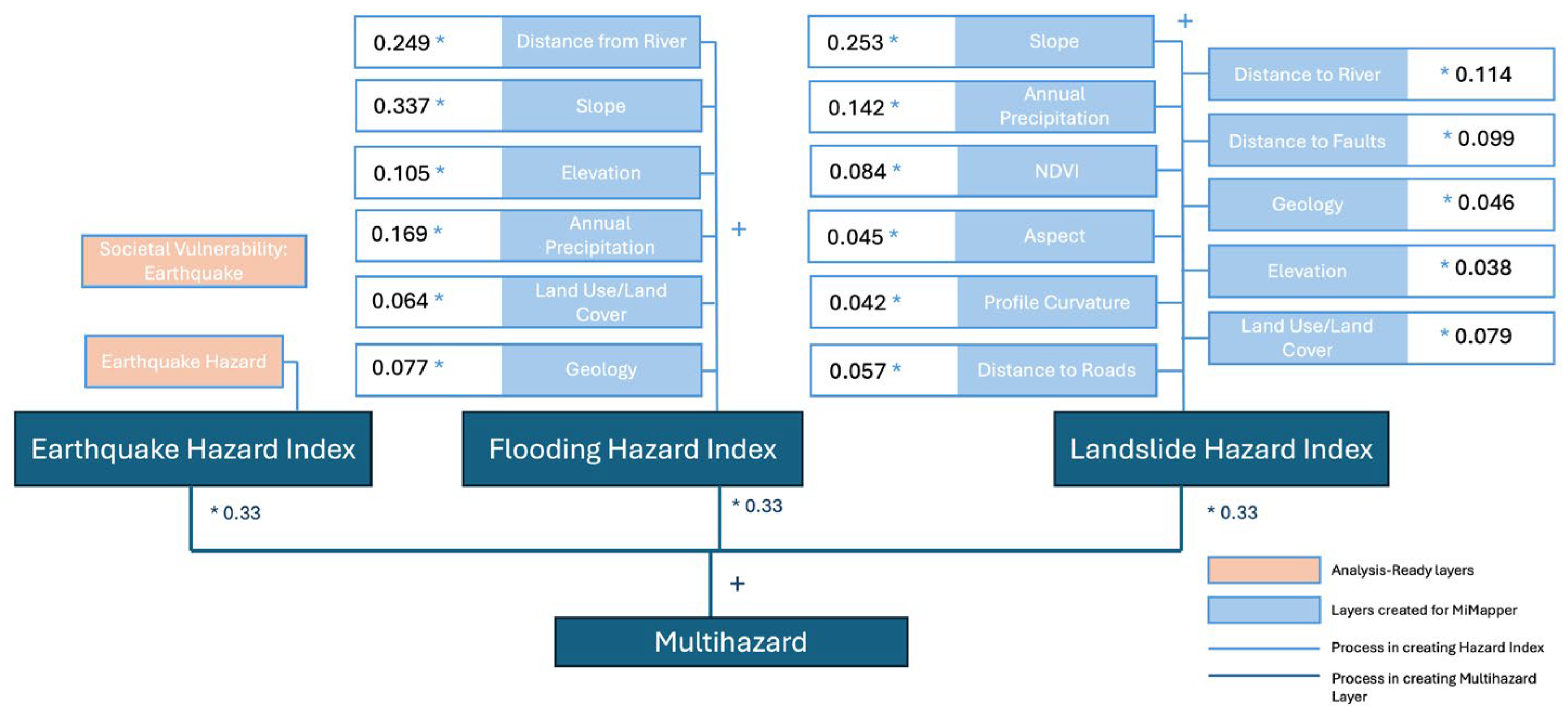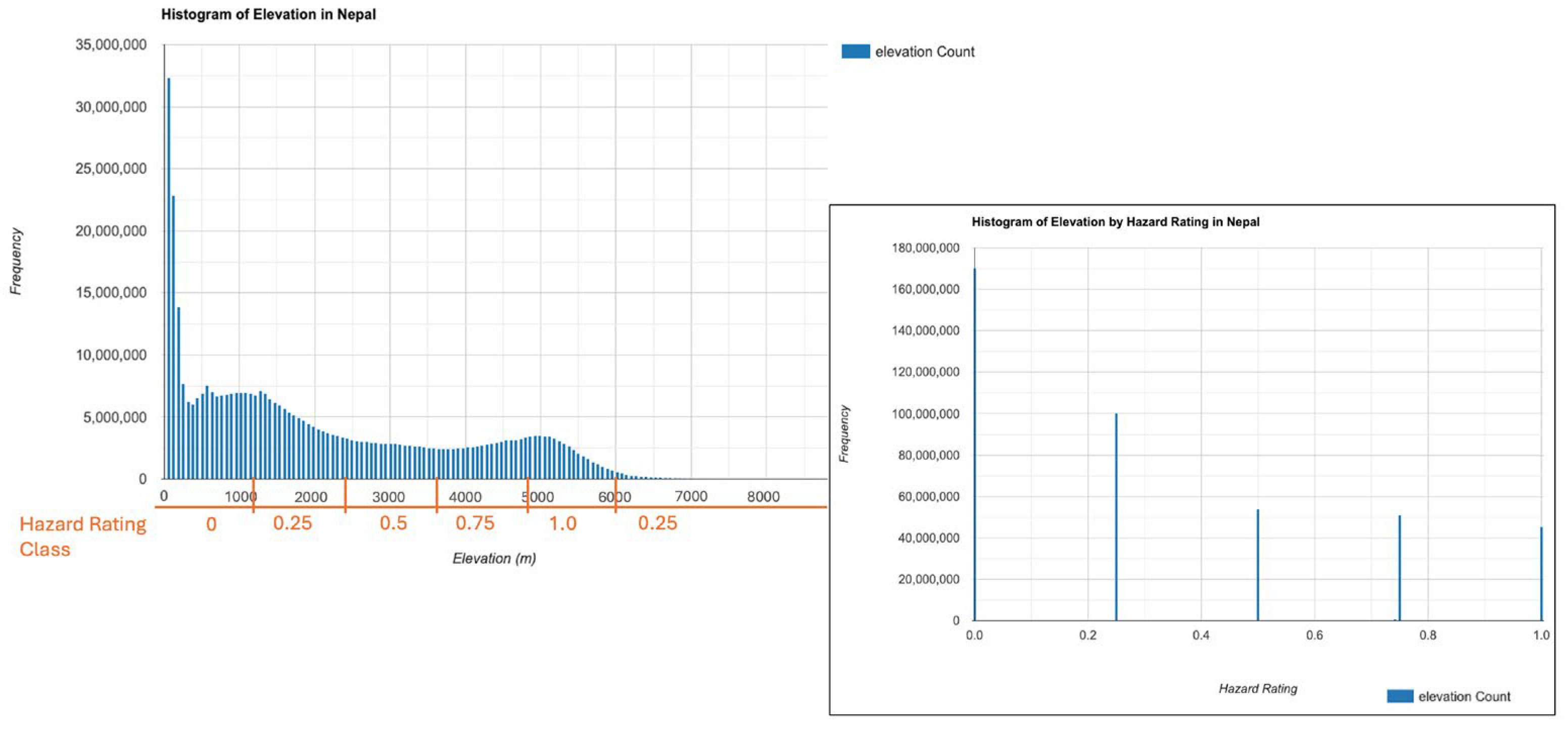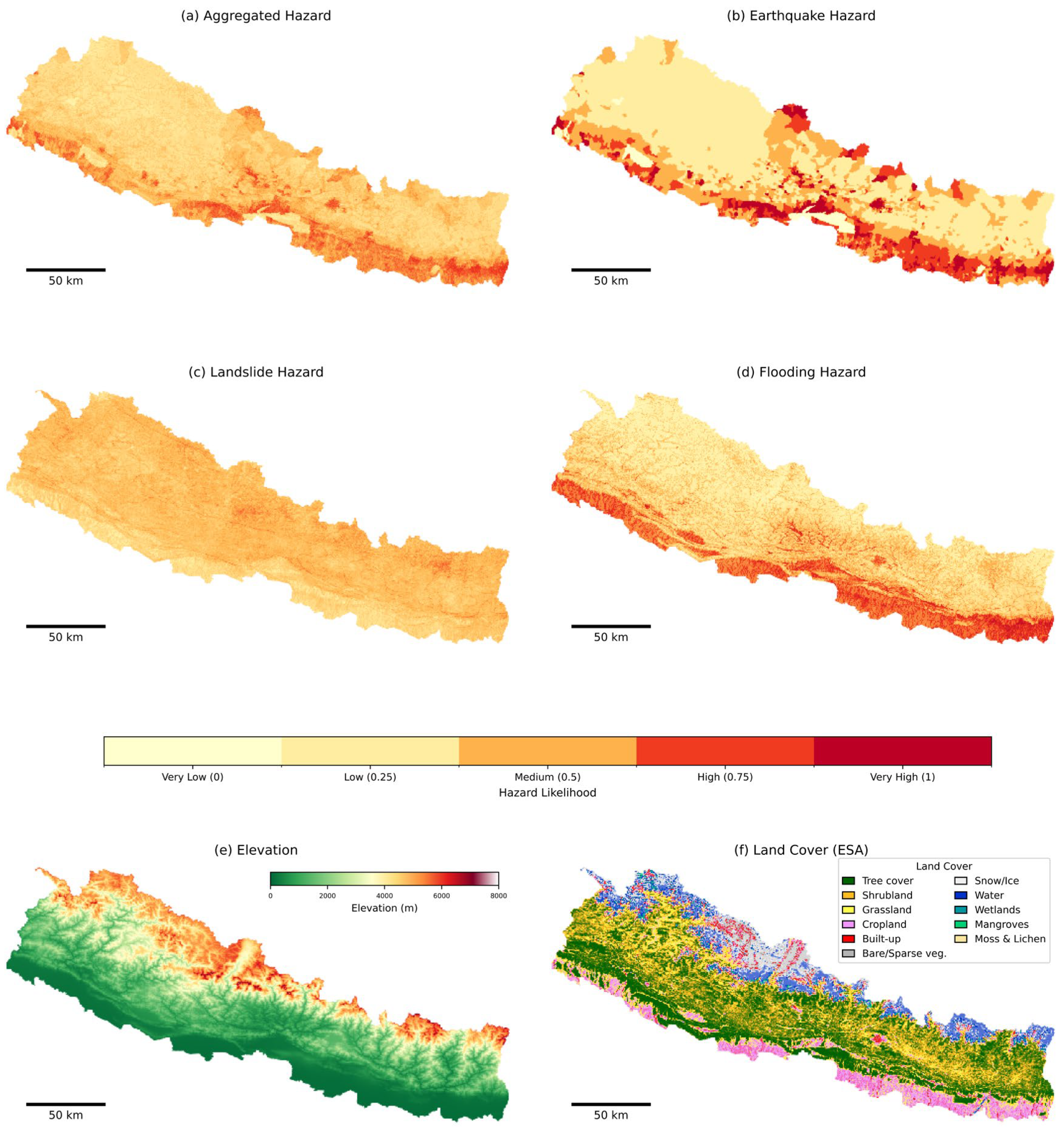MiMapper: A Cloud-Based Multi-Hazard Mapping Tool for Nepal
Abstract
1. Introduction
2. Materials and Methods
2.1. Data Sources and Preprocessing

2.2. Analytical Hierarchy Process (AHP)
2.2.1. Landslides and Flooding Indexes
2.2.2. Earthquake Hazard Index
2.3. Multi-Hazard Index
2.4. MiMapper Validation
2.4.1. Validation: Landslide Hazard Layer
2.4.2. Validation: Flooding Hazard Layer
2.4.3. Validation: Earthquake Hazard Layer
2.5. MiMapper Use and Application
3. Results
3.1. Validation Results
3.1.1. Landslide Hazard Layer Validation
3.1.2. Flooding Hazard Layer Validation
3.1.3. Earthquake Hazard Layer Validation
4. Discussion
4.1. Validation Discussion
4.1.1. Landslide Validation
4.1.2. Flooding Validation
4.1.3. Earthquake Validation
4.2. MiMapper’s Strengths and Limitations
4.2.1. Methodology
4.2.2. Current Strengths and Limitations
4.3. Further Developments of MiMapper
5. Conclusions
Author Contributions
Funding
Data Availability Statement
Conflicts of Interest
Appendix A
| Hazard Layer | Input Layer | Source | Method |
|---|---|---|---|
| Flooding | Distance to River | OpenStreetMap (Rivers) Accessed: 30 September 2024 (https://www.arcgis.com/home/item.html?id=aee12b4062af478fab2832b49fdeb1df) |
|
| Slope | Shuttle Radar Topography Mission (SRTM) digital elevation model (DEM) (through GEE)—30 m resolution dataset Last Date Calculated: 16 December 2024 Data Dates: N/A |
| |
| Elevation | Shuttle Radar Topography Mission (SRTM) digital elevation model (DEM) (through GEE)—30 m resolution dataset Last Date Calculated: 16 December 2024 Data Dates: N/A |
| |
| Annual Precipitation | Climate Hazards Center InfraRed Precipitation with Station data (CHIRPS) Daily Last Date Calculated: 2 December 2024 Data Dates: 2023 |
| |
| Land Cover/Land Use | European Space Agency’s WorldCover 10 m 2021 land cover map based on Sentinel 1 and 2 data. Zanaga, D., Van De Kerchove, R., Daems, D., De Keersmaecker, W., Brockmann, C., Kirches, G., Wevers, J., Cartus, O., Santoro, M., Fritz, S., Lesiv, M., Herold, M., Tsendbazar, N.E., Xu, P., Ramoino, F., Arino, O., 2022. ESA WorldCover 10 m 2021 v200. https://doi.org/10.5281/zenodo.7254221 Data date: 2021 Date Accessed: 10 December 2024 |
| |
| Geology | Geologic map of South Asia Wandrey, C.J., 1998, Geologic map of South Asia (geo8ag): U.S. Geological Survey data release, https://doi.org/10.5066/P9YC1C8G Data date: 1998 Date Accessed: 10 December 2024 |
| |
| Landslide | Slope | Shuttle Radar Topography Mission (SRTM) digital elevation model (DEM) (through GEE)—30 m resolution dataset Last Date Calculated: 16 December 2024 Data Dates: N/A |
|
| Distance to River | OpenStreetMap (Rivers) Accessed: 30 September 2024 (https://www.arcgis.com/home/item.html?id=aee12b4062af478fab2832b49fdeb1df) |
| |
| Annual Precipitation | Climate Hazards Center InfraRed Precipitation with Station data (CHIRPS) Daily Last Date Calculated: 2 December 2024 Data Dates: 2023 |
| |
| Distance to Faults | Geologic map of South Asia Wandrey, C.J., 1998, Geologic map of South Asia (geo8ag): U.S. Geological Survey data release, https://doi.org/10.5066/P9YC1C8G Data date: 1998 Date Accessed: 10 December 2024 |
| |
| NDVI | Landsat 9-Analysis Ready Data Last Date Calculated: 16 December 2024 Data Dates: 1 January 2023 to 1 January 2024 |
| |
| Geology | Geologic map of South Asia Wandrey, C.J., 1998, Geologic map of South Asia (geo8ag): U.S. Geological Survey data release, https://doi.org/10.5066/P9YC1C8G Data date: 1998 Date Accessed: 10 December 2024 |
| |
| Aspect | Shuttle Radar Topography Mission (SRTM) digital elevation model (DEM) (through GEE)—30 m resolution dataset Last Date Calculated: 16 December 2024 Data Dates: N/A |
| |
| Elevation | Shuttle Radar Topography Mission (SRTM) digital elevation model (DEM) (through GEE)—30 m resolution dataset Last Date Calculated: 16 December 2024 Data Dates: N/A |
| |
| Profile Curvature | Shuttle Radar Topography Mission (SRTM) digital elevation model (DEM) (through GEE)—30 m resolution dataset. Last Date Calculated: 16 December 2024 Data Dates: N/A |
| |
| Land Use/Land Cover | European Space Agency’s WorldCover 10 m 2021 land cover map based on Sentinel 1 and 2 data. Zanaga, D., Van De Kerchove, R., Daems, D., De Keersmaecker, W., Brockmann, C., Kirches, G., Wevers, J., Cartus, O., Santoro, M., Fritz, S., Lesiv, M., Herold, M., Tsendbazar, N.E., Xu, P., Ramoino, F., Arino, O., 2022. ESA WorldCover 10 m 2021 v200. https://doi.org/10.5281/zenodo.7254221 Data date: 2021 |
| |
| Distance to Roads | OpenStreetMap (Roads) Accessed: 30 September 2024 (https://www.arcgis.com/home/item.html?id=33838bfa2c08419484f87590cda59f6c) |
|
Appendix B
| Data | Best Threshold | Precision | Sensitivity | Specificity | F1 | Accuracy |
|---|---|---|---|---|---|---|
| Nepal-wide Landslide | 0.692 | 0.668 | 0.804 | 0.567 | 0.730 | 0.690 |
| Langtang Landslide | 0.509 | 0.640 | 0.629 | 0.646 | 0.635 | 0.638 |
| Nepal-wide Flooding | 0.502 | 0.116 | 0.637 | 0.385 | 0.196 | 0.414 |
| Flooding (Event 1) | 0.668 | 0.656 | 0.767 | 0.598 | 0.707 | 0.682 |
| Flooding (Event 2) | 0.666 | 0.653 | 0.788 | 0.582 | 0.714 | 0.685 |
Appendix C
| Hazard Class | Equal Weights (0.33) | Max Aggregation |
|---|---|---|
| Very Low (0) | 0 | 0 |
| Low (0.25) | 45.34 | 02.16 |
| Medium (0.5) | 48.44 | 74.25 |
| High (0.75) | 06.65 | 18.11 |
| Very High (1) | 0 | 05.91 |
| Validation Metric | Flooding (27 September 2024) | Flooding (1 October 2024) | Landslide (Langtang) |
|---|---|---|---|
| Sensitivity | 0.997 | 0.995 | 0.665 |
| Specificity | 0.219 | 0.582 | 0.601 |
| Precision | 0.561 | 0.570 | 0.625 |
| F1 Score | 0.718 | 0.725 | 0.645 |
| Accuracy | 0.608 | 0.623 | 0.633 |
| AUC | 0.737 | 0.704 | 0.682 |
References
- Dimri, A.P.; Allen, S.; Huggel, C.; Mal, S.; Ballesteros-Cánovas, J.A.; Rohrer, M.; Shukla, A.; Tiwari, P.; Maharana, P.; Bolch, T.; et al. Climate Change, Cryosphere and Impacts in the Indian Himalayan Region. Curr. Sci. 2021, 120, 774–790. [Google Scholar] [CrossRef]
- Dewan, T.H. Societal Impacts and Vulnerability to Floods in Bangladesh and Nepal. Weather Clim. Extrem. 2015, 7, 36–42. [Google Scholar] [CrossRef]
- Shrestha, A.B.; Aryal, R. Climate Change in Nepal and Its Impact on Himalayan Glaciers. Reg. Environ. Change 2011, 11, 65–77. [Google Scholar] [CrossRef]
- Hannah, D.M.; Kansakar, S.R.; Gerrard, A.J.; Rees, G. Flow Regimes of Himalayan Rivers of Nepal: Nature and Spatial Patterns. J. Hydrol. 2005, 308, 18–32. [Google Scholar] [CrossRef]
- Richardson, S.D.; Reynolds, J.M. An Overview of Glacial Hazards in the Himalayas. Quat. Int. 2000, 65–66, 31–47. [Google Scholar] [CrossRef]
- Xu, J.; Grumbine, R.E.; Shrestha, A.; Eriksson, M.; Yang, X.; Wang, Y.; Wilkes, A. The Melting Himalayas: Cascading Effects of Climate Change on Water, Biodiversity, and Livelihoods. Conserv. Biol. 2009, 23, 520–530. [Google Scholar] [CrossRef]
- Reynolds, J.M. The Role of Integrated Geohazard Assessments in Disaster Risk Management. Int. J. Hydropower Dams 2023, 30, 43–56. [Google Scholar]
- Ministry of Home Affairs (MoHA); Disaster Preparedness Network Nepal (DPNet Nepal). Nepal Disaster Report 2013; Ministry of Home Affairs: Kathmandu, Nepal, 2013. [Google Scholar]
- Koirala, M.; Rai, M.R.; Maskey, R.; Tribhuvana Viśvavidyālaya, United Nations Development Programme (Nepal) (Eds.) Disaster Risk Management: Concept, Policy and Practices in Nepal; Central Department of Environmental Science, Tribhuvan University: Kirtipur, Nepal, 2015; ISBN 978-9937-2-9764-6. [Google Scholar]
- Chaulagain, H.; Rodrigues, H.; Silva, V.; Spacone, E.; Varum, H. Seismic Risk Assessment and Hazard Mapping in Nepal. Nat. Hazards 2015, 78, 583–602. [Google Scholar] [CrossRef]
- Wesnousky, S.G.; Kumahara, Y.; Chamlagain, D.; Pierce, I.K.; Karki, A.; Gautam, D. Geological Observations on Large Earthquakes along the Himalayan Frontal Fault near Kathmandu, Nepal. Earth Planet. Sci. Lett. 2017, 457, 366–375. [Google Scholar] [CrossRef]
- Goda, K.; Kiyota, T.; Pokhrel, R.M.; Chiaro, G.; Katagiri, T.; Sharma, K.; Wilkinson, S. The 2015 Gorkha Nepal Earthquake: Insights from Earthquake Damage Survey. Front. Built Environ. 2015, 1, 153814. [Google Scholar] [CrossRef]
- Fujita, K.; Inoue, H.; Izumi, T.; Yamaguchi, S.; Sadakane, A.; Sunako, S.; Nishimura, K.; Immerzeel, W.W.; Shea, J.M.; Kayastha, R.B.; et al. Anomalous Winter-Snow-Amplified Earthquake-Induced Disaster of the 2015 Langtang Avalanche in Nepal. Nat. Hazards Earth Syst. Sci. 2017, 17, 749–764. [Google Scholar] [CrossRef]
- Lacroix, P. Landslides Triggered by the Gorkha Earthquake in the Langtang Valley, Volumes and Initiation Processes. Earth Planets Space 2016, 68, 46. [Google Scholar] [CrossRef]
- Mani, P.; Allen, S.; Evans, S.G.; Kargel, J.S.; Mergili, M.; Petrakov, D.; Stoffel, M. Geomorphic Process Chains in High-Mountain Regions—A Review and Classification Approach for Natural Hazards Assessment. Rev. Geophys. 2023, 61, e2022RG000791. [Google Scholar] [CrossRef]
- Dahal, B.K.; Dahal, R.K. Landslide Hazard Map: Tool for Optimization of Low-Cost Mitigation. Geoenviron. Disasters 2017, 4, 8. [Google Scholar] [CrossRef]
- Froude, M.J.; Petley, D.N. Global Fatal Landslide Occurrence from 2004 to 2016. Nat. Hazards Earth Syst. Sci. 2018, 18, 2161–2181. [Google Scholar] [CrossRef]
- Pangali Sharma, T.P.; Zhang, J.; Koju, U.A.; Zhang, S.; Bai, Y.; Suwal, M.K. Review of Flood Disaster Studies in Nepal: A Remote Sensing Perspective. Int. J. Disaster Risk Reduct. 2019, 34, 18–27. [Google Scholar] [CrossRef]
- Lamichhane, K.; Karki, S.; Sharma, K.; Khadka, B.; Acharya, B.; Biswakarma, K.; Adhikari, S.; Kc, R.; Danegulu, A.; Bhattarai, S.; et al. Unraveling the Causes and Impacts of Increasing Flood Disasters in the Kathmandu Valley: Lessons from the Unprecedented September 2024 Floods. Nat. Hazards Res. 2025, S2666592125000435. [Google Scholar] [CrossRef]
- Moktan, S.; Kafle, K.R.; Chapagain, S. Social Vulnerability Assessment to Natural Hazards in Western Nepal. In Sustainable Cities and Resilience; Lecture Notes in Civil Engineering; Pal, I., Kolathayar, S., Eds.; Springer: Singapore, 2022; Volume 183, pp. 103–114. ISBN 978-981-16-5542-5. [Google Scholar]
- Kincey, M.E.; Rosser, N.J.; Swirad, Z.M.; Robinson, T.R.; Shrestha, R.; Pujara, D.S.; Basyal, G.K.; Densmore, A.L.; Arrell, K.; Oven, K.J.; et al. National-Scale Rainfall-Triggered Landslide Susceptibility and Exposure in Nepal. Earth’s Future 2024, 12, e2023EF004102. [Google Scholar] [CrossRef]
- Shrestha, M.; Noppradit, P.; Shrestha, R.P.; Dahal, R.K. Understanding Livelihood Insecurity Due to Landslides in the Mid-Hill of Nepal: A Case Study of Bahrabise Municipality. Int. J. Disaster Risk Reduct. 2024, 104, 104399. [Google Scholar] [CrossRef]
- Gariano, S.L.; Guzzetti, F. Landslides in a Changing Climate. Earth-Sci. Rev. 2016, 162, 227–252. [Google Scholar] [CrossRef]
- METEOR Project Consortium. METEOR Explorer-Nepal Multihazard Map, version 1.0. Available online: https://maps.meteor-project.org/map/npl-mhz/#7/28.022/84.014 (accessed on 30 July 2025).
- Han, L.; Zhang, J.; Zhang, Y.; Ma, Q.; Alu, S.; Lang, Q. Hazard Assessment of Earthquake Disaster Chains Based on a Bayesian Network Model and ArcGIS. ISPRS Int. J. Geo-Inf. 2019, 8, 210. [Google Scholar] [CrossRef]
- Bhattarai, M.K. Information and Communication Technology Scenario of Nepal: Assessing Policy Environment and Challenges. Nep. Pub. Pol. Rev. 2021, 1, 201–211. [Google Scholar] [CrossRef]
- Karn, N.K.; Hongli, Z.; Shafiq, M. Measuring Broadband Internet Performance in Nepal: A Comparative Study. Procedia Comput. Sci. 2017, 107, 64–69. [Google Scholar] [CrossRef]
- Bhochhibhoya, S.; Maharjan, R. Integrated Seismic Risk Analysis—Nepal (Outputs); Zenodo: Geneva, Switzerland, 2022. [Google Scholar]
- Bhochhibhoya, S.; Maharjan, R. Integrated Seismic Risk Assessment in Nepal. Nat. Hazards Earth Syst. Sci. 2022, 22, 3211–3230. [Google Scholar] [CrossRef]
- Khatakho, R.; Gautam, D.; Aryal, K.R.; Pandey, V.P.; Rupakhety, R.; Lamichhane, S.; Liu, Y.-C.; Abdouli, K.; Talchabhadel, R.; Thapa, B.R.; et al. Multi-Hazard Risk Assessment of Kathmandu Valley, Nepal. Sustainability 2021, 13, 5369. [Google Scholar] [CrossRef]
- Dahigamuwa, T.; Yu, Q.; Gunaratne, M. Feasibility Study of Land Cover Classification Based on Normalized Difference Vegetation Index for Landslide Risk Assessment. Geosciences 2016, 6, 45. [Google Scholar] [CrossRef]
- Huang, S.; Tang, L.; Hupy, J.P.; Wang, Y.; Shao, G. A Commentary Review on the Use of Normalized Difference Vegetation Index (NDVI) in the Era of Popular Remote Sensing. J. For. Res. 2021, 32, 1–6. [Google Scholar] [CrossRef]
- Xue, J.; Su, B. Significant Remote Sensing Vegetation Indices: A Review of Developments and Applications. J. Sens. 2017, 2017, 1353691. [Google Scholar] [CrossRef]
- Wandrey, C.J. Geologic Map of South Asia (Geo8ag); U.S. Geological Survey: Reston, VA, USA, 1998. [Google Scholar]
- Nepal National Spatial Data Center. National Geoportal–Nepal Boundary Layer. Available online: https://admin.nationalgeoportal.gov.np/layers/geonode:nepal (accessed on 15 November 2024).
- Das, S.; Sarkar, S.; Kanungo, D.P. GIS-Based Landslide Susceptibility Zonation Mapping Using the Analytic Hierarchy Process (AHP) Method in Parts of Kalimpong Region of Darjeeling Himalaya. Environ. Monit. Assess. 2022, 194, 234. [Google Scholar] [CrossRef]
- Bhat, I.A.; Ahmed, R.; Bhat, W.A.; Ahmed, P. Application of AHP Based Geospatial Modeling for Assessment of Landslide Hazard Zonation along Mughal Road in the Pir Panjal Himalayas. Environ. Earth Sci. 2023, 82, 336. [Google Scholar] [CrossRef]
- Sar, N.; Chatterjee, S.; Das Adhikari, M. Integrated Remote Sensing and GIS Based Spatial Modelling through Analytical Hierarchy Process (AHP) for Water Logging Hazard, Vulnerability and Risk Assessment in Keleghai River Basin, India. Model. Earth Syst. Environ. 2015, 1, 31. [Google Scholar] [CrossRef]
- Dahal, R.K. Regional-Scale Landslide Activity and Landslide Susceptibility Zonation in the Nepal Himalaya. Environ. Earth Sci. 2014, 71, 5145–5164. [Google Scholar] [CrossRef]
- Moreira, L.L.; De Brito, M.M.; Kobiyama, M. Effects of Different Normalization, Aggregation, and Classification Methods on the Construction of Flood Vulnerability Indexes. Water 2021, 13, 98. [Google Scholar] [CrossRef]
- Hanley, J.A.; McNeil, B.J. The Meaning and Use of the Area under a Receiver Operating Characteristic (ROC) Curve. Radiology 1982, 143, 29–36. [Google Scholar] [CrossRef] [PubMed]
- Marzban, C. The ROC Curve and the Area under It as Performance Measures. Weather Forecast. 2004, 19, 1106–1114. [Google Scholar] [CrossRef]
- Rahmati, O.; Yousefi, S.; Kalantari, Z.; Uuemaa, E.; Teimurian, T.; Keesstra, S.; Pham, T.; Tien Bui, D. Multi-Hazard Exposure Mapping Using Machine Learning Techniques: A Case Study from Iran. Remote Sens. 2019, 11, 1943. [Google Scholar] [CrossRef]
- Youden, W.J. Technique for Testing Accuracy of Analytical Data. Anal. Chem. 1947, 19, 946–950. [Google Scholar] [CrossRef]
- Harvey, E.L.; Kincey, M.E.; Rosser, N.J.; Gadtaula, A.; Collins, E. Landslide Inventories for Nepal: Database 2010–2021; Zenodo: Geneva, Switzerland, 2023. [Google Scholar]
- Harvey, E.L.; Kincey, M.E.; Rosser, N.J.; Gadtaula, A.; Collins, E.; Densmore, A.L.; Dunant, A.; Oven, K.J.; Arrell, K.; Basyal, G.K.; et al. Review of Landslide Inventories for Nepal between 2010 and 2021 Reveals Data Gaps in Global Landslide Hotspot. Nat. Hazards 2025, 121, 5075–5101. [Google Scholar] [CrossRef]
- British Geological Survey (BGS). Polygon Inventory of 183 Landslides Mapped Across Langtang Valley, Nepal (NERC Grant NE/L002582/1); British Geological Survey: Nottingham, UK, 2025. [Google Scholar]
- National Disaster Risk Reduction and Management Authority (NDRRMA). BIPAD Portal. Ministry of Home Affairs, Government of Nepal. 2025. Available online: https://bipadportal.gov.np/ (accessed on 30 June 2025).
- UNOSAT. Satellite Detected Water Extent, Koshi and Madhesh Provinces, Nepal, as of 01 October 2024. 2024. Available online: https://data.humdata.org/dataset/satellite-detected-water-extent-koshi-and-madhesh-provinces-nepal-as-of-01-october-2024?force_layout=desktop (accessed on 29 June 2025).
- Storchak, D.A.; Di Giacomo, D.; Engdahl, E.R.; Harris, J.; Bondár, I.; Lee, W.H.K.; Bormann, P.; Villaseñor, A. The ISC-GEM Global Instrumental Earthquake Catalogue (1900–2009): Introduction. Phys. Earth Planet. Inter. 2015, 239, 48–63. [Google Scholar] [CrossRef]
- Di Giacomo, D.; Engdahl, E.R.; Storchak, D.A. The ISC-GEM Earthquake Catalogue (1904–2014): Status after the Extension Project. Earth Syst. Sci. Data 2018, 10, 1877–1899. [Google Scholar] [CrossRef]
- Storchak, D.A.; Di Giacomo, D.; Bondar, I.; Engdahl, E.R.; Harris, J.; Lee, W.H.K.; Villasenor, A.; Bormann, P. Public Release of the ISC-GEM Global Instrumental Earthquake Catalogue (1900–2009). Seismol. Res. Lett. 2013, 84, 810–815. [Google Scholar] [CrossRef]
- Dandridge, C.; Stanley, T.A.; Kirschbaum, D.B.; Lakshmi, V. Spatial and Temporal Analysis of Global Landslide Reporting Using a Decade of the Global Landslide Catalog. Sustainability 2023, 15, 3323. [Google Scholar] [CrossRef]
- Jena, R.; Pradhan, B.; Almazroui, M.; Assiri, M.; Park, H.-J. Earthquake-Induced Liquefaction Hazard Mapping at National-Scale in Australia Using Deep Learning Techniques. Geosci. Front. 2023, 14, 101460. [Google Scholar] [CrossRef]
- Rahman, M.Z.; Siddiqua, S.; Kamal, A.S.M.M. Liquefaction Hazard Mapping by Liquefaction Potential Index for Dhaka City, Bangladesh. Eng. Geol. 2015, 188, 137–147. [Google Scholar] [CrossRef]
- Youd, T.L.; Perkins, D.M. Mapping of Liquefaction Severity Index. J. Geotech. Eng. 1987, 113, 1374–1392. [Google Scholar] [CrossRef]
- Dhital, M.R. Geology of the Nepal Himalaya; Regional Geology Reviews; Springer International Publishing: Cham, Switzerland, 2015; ISBN 978-3-319-02495-0. [Google Scholar]
- Chen, C.-M.; Hollingsworth, J.; Clark, M.K.; Chamlagain, D.; Bista, S.; Zekkos, D.; Siwakoti, A.; West, A.J. Erosional Cascade during the 2021 Melamchi Flood. Nat. Geosci. 2025, 18, 32–36. [Google Scholar] [CrossRef]
- Pradhan, A.M.S.; Ghimire, P.; Bishwas, N. From Data to Predictions: Landslide Susceptibility Map of Nepal. Google Earth Engine, 2025. Available online: https://wrradc.users.earthengine.app/view/landsusnepal (accessed on 29 June 2025).


| MiMapper Category | Aggregated Hazard | Earthquake Hazard | Flooding Hazard | Landslide Hazard |
|---|---|---|---|---|
| Very High | 0.00 | 5.82 | 0.47 | 0.00 |
| High | 6.64 | 12.60 | 13.92 | 0.09 |
| Medium | 48.44 | 21.95 | 33.15 | 81.14 |
| Low | 45.34 | 57.62 | 52.72 | 18.97 |
| Very Low | 0.00 | 2.15 | 0.12 | 0.00 |
| Validation Metric | Flooding | Landslide |
|---|---|---|
| Sensitivity | 0.637 | 0.898 |
| Specificity | 0.383 | 0.419 |
| Precision | 0.116 | 0.627 |
| F1 Score | 0.196 | 0.738 |
| Accuracy | 0.412 | 0.668 |
| AUC | 0.470 | 0.719 |
Disclaimer/Publisher’s Note: The statements, opinions and data contained in all publications are solely those of the individual author(s) and contributor(s) and not of MDPI and/or the editor(s). MDPI and/or the editor(s) disclaim responsibility for any injury to people or property resulting from any ideas, methods, instructions or products referred to in the content. |
© 2025 by the authors. Licensee MDPI, Basel, Switzerland. This article is an open access article distributed under the terms and conditions of the Creative Commons Attribution (CC BY) license (https://creativecommons.org/licenses/by/4.0/).
Share and Cite
Price, C.A.; Jones, M.; Glasser, N.F.; Reynolds, J.M.; Kayastha, R.B. MiMapper: A Cloud-Based Multi-Hazard Mapping Tool for Nepal. GeoHazards 2025, 6, 63. https://doi.org/10.3390/geohazards6040063
Price CA, Jones M, Glasser NF, Reynolds JM, Kayastha RB. MiMapper: A Cloud-Based Multi-Hazard Mapping Tool for Nepal. GeoHazards. 2025; 6(4):63. https://doi.org/10.3390/geohazards6040063
Chicago/Turabian StylePrice, Catherine A., Morgan Jones, Neil F. Glasser, John M. Reynolds, and Rijan B. Kayastha. 2025. "MiMapper: A Cloud-Based Multi-Hazard Mapping Tool for Nepal" GeoHazards 6, no. 4: 63. https://doi.org/10.3390/geohazards6040063
APA StylePrice, C. A., Jones, M., Glasser, N. F., Reynolds, J. M., & Kayastha, R. B. (2025). MiMapper: A Cloud-Based Multi-Hazard Mapping Tool for Nepal. GeoHazards, 6(4), 63. https://doi.org/10.3390/geohazards6040063







